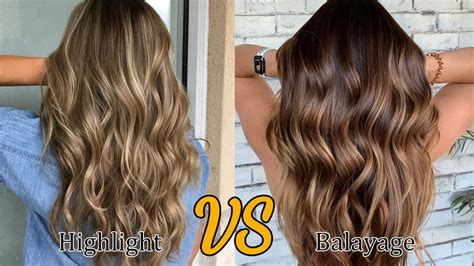Introduction

Balayage and highlights are two popular hair coloring techniques that can create stunning effects. While they share some similarities, there are also key differences between the two. This side-by-side comparison will help you understand the distinctions and make an informed decision about which technique is right for you.
Technique
Balayage: Balayage is a freehand painting technique that involves applying bleach or color to select strands of hair. The stylist uses a sweeping motion to create a natural, sun-kissed effect.
Highlights: Highlights are created by isolating individual strands of hair and wrapping them in foil or paper before applying bleach or color. This technique provides more precise control over the placement of the color.
Appearance
Balayage: Balayage creates a subtle, blended effect that mimics natural highlights. The transition from roots to tips is gradual, with no harsh lines.
Highlights: Highlights are bolder and more defined, creating a more dramatic look. The contrast between the highlighted strands and the base color is more noticeable.
Maintenance
Balayage: Balayage requires less maintenance than highlights. The blended effect allows for longer intervals between touch-ups.
Highlights: Highlights require regular touch-ups to maintain their vibrant appearance. Typically, you’ll need to touch up your highlights every 6-8 weeks.
Cost
Balayage: Balayage tends to be more expensive than highlights, as it requires more skill and time to create.
Highlights: Highlights are generally less expensive than balayage, making them a more affordable option for those on a budget.
Pros and Cons
Balayage
Pros:
– Natural, sun-kissed effect
– Less maintenance
– Suitable for all hair types
Cons:
– Can be more expensive
– May not be as long-lasting as highlights
– Requires skilled stylist
Highlights
Pros:
– Bold, dramatic look
– More precise placement
– Long-lasting
Cons:
– More maintenance
– Can be damaging to fine hair
– Requires regular touch-ups
Step-by-Step Comparison
| Balayage | Highlights |
|---|---|
| Application: Freehand painting using a sweeping motion | Individual strands wrapped in foil or paper |
| Placement: Select strands, focusing on mid-lengths and ends | Precise placement of highlights, from roots to tips |
| Effect: Subtle, blended, sun-kissed | Bold, defined, dramatic |
| Maintenance: Less maintenance, longer intervals between touch-ups | More maintenance, regular touch-ups required |
| Cost: More expensive | Less expensive |
| Skill Level: Requires skilled stylist | Can be done by experienced stylist or at home |
Uses
Both balayage and highlights can be used to enhance a wide range of hairstyles. However, they serve different purposes:
- Balayage: Ideal for creating a natural, sun-kissed look, adding depth and dimension to long hair.
- Highlights: Suitable for creating bold, dramatic effects, adding brightness and dimension to shorter hairstyles or adding volume to fine hair.
Customer Wants and Needs
When choosing between balayage and highlights, it’s important to consider your individual wants and needs:
- Natural look: Balayage is a better option if you prefer a subtle, sun-kissed effect.
- Dramatic look: Highlights are the way to go if you want a bolder, more defined look.
- Low maintenance: Balayage is less maintenance-intensive than highlights.
- Affordable: Highlights are generally less expensive than balayage.
- Skillful stylist: Balayage requires a skilled stylist to create the desired effect.
Conclusion
Balayage and highlights are both versatile hair coloring techniques that can create stunning effects. While balayage offers a more natural, sun-kissed look with less maintenance, highlights provide bolder, defined results with higher maintenance. Understanding the differences between the two techniques will help you make an informed decision that aligns with your individual style and preferences.
